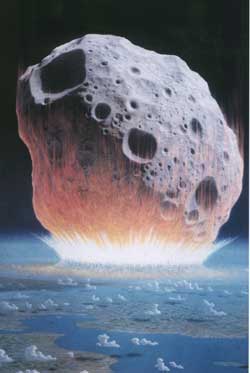|
 The
closest observed large asteroid yet to skim past the Earth
without hitting the atmosphere was reported by astronomers
on Sunday, August 22, 2004. The
closest observed large asteroid yet to skim past the Earth
without hitting the atmosphere was reported by astronomers
on Sunday, August 22, 2004.
"It was close enough to strike, and
if it did, it would have alerted US and Russian nuclear
detonation satellites and caused a major alert 'stink'
of unknown magnitude," said Steven Chesley of JPL
(Jet Propulsion Laboratories). Chesley noted that the
atmospheric grazing did in fact alert US, Russian and
Chinese satellites that monitor exo-atmospheric thermal
events and probably did trigger alarms around the globe.
"I am not privy to what events happened
when the Russians first detected it, but I have a phone
to explain these things to people that are higher in rank
than me, and I did pick up my phone right away to explain
it," said Chesley. "They saw it too, and didn't
go belligerent like in 1996."
Chesley was referring to the 1996 Norwegian
atmospheric rocket test that put Russian Strategic Rocket
Forces on powered launch alert and resulted in nuclear
launch codes being handed to a very drunk Boris Yeltsin
in the Kremlin at 3 a.m. Moscow time. After several phone
calls, a sober Russian General realized that it was a
planned test that the Russians were notified about months
in advance, and he deactivated the launch alert and powered
down all the strategic missiles that were being wound
up for launch.
The previously unknown object, spanning
five to 10 metres across, has been named 2004 FU162. No
scientist has gone on record to say why they came up with
the designation of FU beyond "Fuck You." It
streaked across the sky just 6500 kilometres - roughly
the radius of the Earth - above the ground on 31 March,
although details have only now emerged.
The MIT Lincoln Laboratory's asteroid-hunting
LINEAR telescope in Socorro, New Mexico, US, observed
the new object four times over a 44-minute period, several
hours before its closest approach in March. They said
it was the largest object to come close to impacting Earth
since their observations began, and they don't know yet
why it was such a surprise.
Lincoln astronomers, who have discovered
over 40,000 asteroids and comets since 1980, quickly recognized
the object came exceptionally close, and posted their
findings for confirmation on a web page run by the Minor
Planet Center at the Harvard-Smithsonian Center for Astrophysics.
However, by the time it was posted the
object had moved into the daytime sky, so follow-up observations
were impossible and the listing was quickly removed. A
search for prior observations yielded no results.
Dissipated harmlessly
Despite having only four positions for
the object, Steven Chesley of NASA’s Jet Propulsion
Laboratory was able to calculate its orbit because it
was moving rapidly across the sky.
He also calculated that the encounter
with the Earth shifted the asteroid's orbit closer towards
the Sun. Previously orbiting the Sun once a year in an
orbit that ranged as far inside the Earth's orbit as outside,
2004 FU162 now has a nine-month orbit centered closer
to Venus than the Earth. The Minor Planet Center published
Chesley’s results on Sunday in its electronic circular.
"This was an extraordinarily close
encounter and so the orbital change was quite extraordinary.
2004 FU162 was deflected by about 20 degrees because of
the Earth's gravity. I've never seen anything like that
before," Chesley told New Scientist. "Something
made the orbit change, but we don't know what, yet."
The previous record for the closest asteroid
approach to Earth was set on 18 March by an object called
2004 FH which missed the Earth by about 40,000 kilometres.
That was a much larger object, around
30 meters in diameter - big enough to produce a one-megaton
explosion in the atmosphere. Although it was likely to
have exploded so high that the energy would have dissipated
harmlessly. The smaller 2004 FU162 is assumed to have
burned up as a fireball ending with a smaller explosion,
had it ventured into the Earth’s atmosphere. But
that depends on what the composition of the object was.
"If it was metallic, it would have
probably survived entry and possibly hit the Earth and
caused real bad destruction," said Chesley. "I
wouldn't have wanted to have been near it if it hit."
|